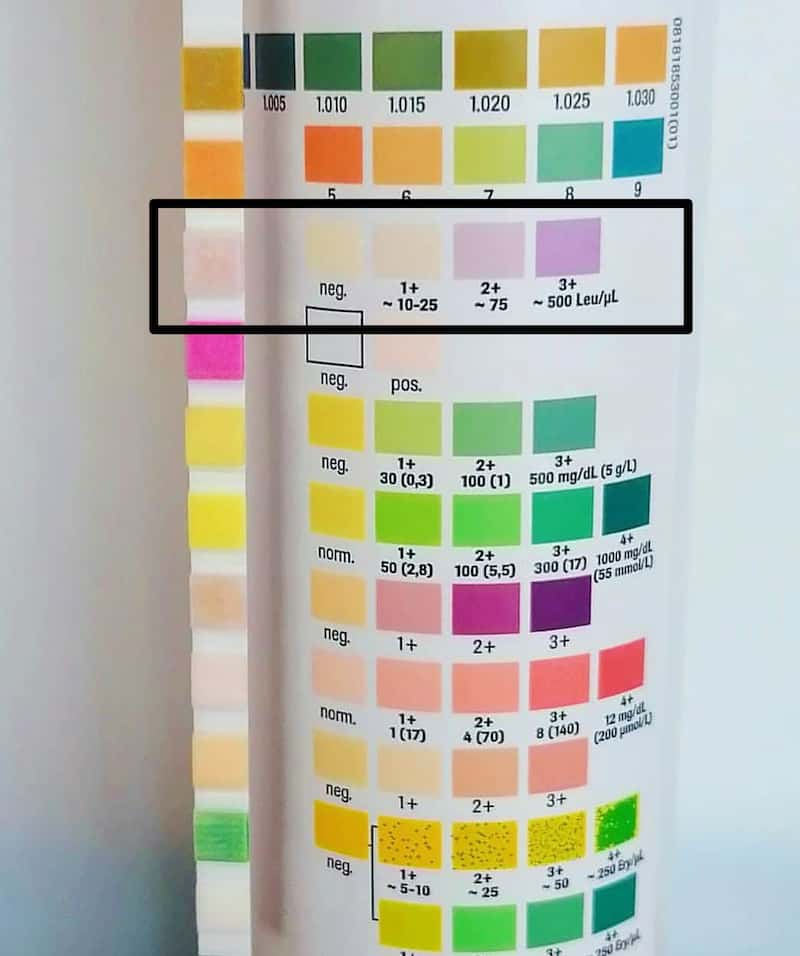Summary :
The Leukocyte Esterase urine test is commonly used to screen for urinary tract infections and other conditions that cause inflammation of the urinary tract.
This article explains how the test works, how it is performed, and what the results mean. It also discusses the limitations and potential pitfalls of the test.
◉ Definition
Leukocyte esterase is an esterase-like enzyme produced by certain types of white blood cells (also called leukocytes). This enzyme is mainly used as a marker to detect the presence of leukocytes in the urine.
It is a simple and rapid screening test that simply requires a clean urine catch to be performed in your home or in a medical setting. A positive leukocyte esterase urine test is often indicative of urinary tract infections (UTIs).
It is usually performed using a test strip or an automated analyzer. Both methods are widely used and can provide reliable results when used correctly.
It is important to note that the leukocyte esterase test is not a definitive diagnostic tool and should be used in conjunction with other tests, such as the nitrite urine test, and the patient's clinical presentation to arrive at a diagnosis.

Measurement of leukocyte esterase using dipstick
◉ What does it mean if Leukocyte Esterase urine test is too high
If you receive a positive leukocyte esterase result that suggests a high level of leukocytes in your urine, it often indicates inflammation, infection or other urinary system issues (See causes of leucocytes in urine).
◉ What normal results of Leukocyte Esterase urine test
A negative Leukocyte Esterase test result is considered normal. This means that leukocytes are not detected in the urine sample and suggests that there is likely no significant inflammation or infection in the urinary tract
◉ Principle of Leukocyte Esterase
The Leukocyte Esterase Test is designed to detect the presence of an enzyme called leukocyte esterase, which is released by certain types of white blood cells, including neutrophils, macrophages, and eosinophils, when they are present in the urine.
- These esterases can be detected by test strips which contain an appropriate substrate such as indoxylcarbonic acid ester.
- When the strip is dipped into the urine sample, the reagent on the swab will react with any leukocyte esterase present in the urine.
- This reaction results in a color change of the reagent, indicating the presence of leukocytes.
The color intensity is proportional to the number of leukocytes in a sample ranging from lavender to purple. Results are reported semi-quantitatively as negative, trace, 1+, 2+, or 3+ (or negative, trace, small, moderate, large).
◉ How the Test is Performed
The Leukocyte Esterase Test is a simple, non-invasive procedure that can be performed in a clinical setting or at home using a test strip. Here are the main steps:
- Wash your hands thoroughly and then your genital area with soap and water.
- Start urinating into the toilet, then stop and place the sterile collection container under your urine stream.
- Collect at least 30 milliliters of urine in the container, then finish urinating in the toilet.
- Remove a strip from its wrapper.
- Soak the strip in the urine sample for the recommended time (usually a few seconds).
- Remove the test strip from the urine and tap it gently to remove excess urine.
- Wait recommended time (usually 2 minutes) for test results to develop.
Note : The most accurate results are obtained on fresh, uncentrifuged and well-mixed samples at room temperature.
◉ Results
A leukocyte esterase test is read by comparing the color of the test strip to a color chart provided by the manufacturer. The color of the test strip will change depending on the activity level of leukocyte esterases in the urine sample. As the leukocyte concentration increases, the color of the pad changes from light beige to dark or bright purple.
- If there are only traces of white blood cells (approximately 15 cells/µL), the color of the reagent pad on the strip may change to beige or to light brown.
- A light purple color indicates low levels of leukocytes (approximately 75 cells/µL).
- A moderate level (approximately 125 cells/µL) appearing as a darker purple color.
- The reagent pad turns dark purple when the maximum detectable level of 500 cells/µL leukocytes is present.

Leukocyte esterase test results
◉ Interpretation
The number of white blood cells per microliter varies slightly depending on the standardized procedure used. Normally, a few leukocytes are present in the urine: 0 to 8 per high magnification field, or about 10 white blood cells per microlitre.
An increased number of white blood cells in the urine indicates infection or inflammation anywhere in the urinary tract. A combination of positive results for leukocytes and nitrites in urine is a good indicator of urinary tract infections (Cystitis, Kidney infection, etc.).